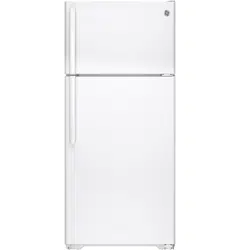Documents: Go to download!
- User Manual - (English, French, Spanish)
- USING THE REFRIGERATOR
- Care And Cleaning
- Troubleshooting Tips.
Table of contents
User manual Refrigerator
USING THE REFRIGERATOR
Temperature Control
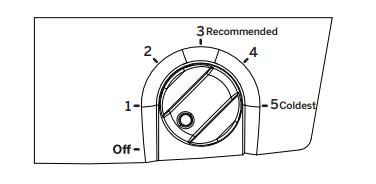
The temperature control adjusts the refrigerator from its warmest to coldest settings. Your refrigerator will come with the recommended factory setting on 3. For colder temaparature, turn the knob clockwise to either setting 4 or 5. For warmer temparature, turn the dial counter-clockwise to either setting 1 or 2. To turn off the cooling in both campartments, turn the knob counter-clockwise to setting off. Note that this does not shut off power to the refrigerator.
Fresh Food Compartment Shelves
Shelf supports at various levels allow you to custom-space your shelves. Not all features are on all models.
Full-Width Shelves
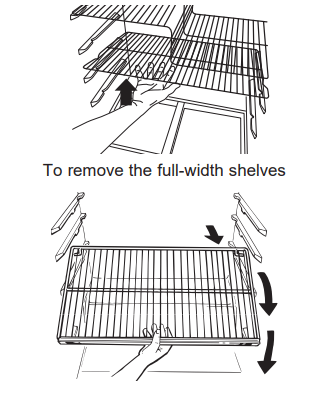
Some models have a stationary tempered glass shelf, a spillproof shelf or two steel wire stationary shelves. These shelves can be moved to another place in the fresh food compartment. When placed correctly on the shelf supports, the shelf will stop before coming completely out of the refrigerator and will not tilt when you place food on it or remove food from it
Freezer Compartment Shelves
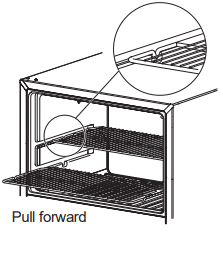
When placed correctly on the shelf supports, the two steel wire stationary shelves will stop before coming completely out of the freezer and will not tilt when you place food on it or remove food from it. Some models have glass shelves.
Storage Drawers
Not all features are on all models. Snack Drawer
The snack drawer can be moved to the most useful location for your family’s needs.

Fruit and Vegetable Drawers
Excess water that may accumulate in the bottom of the drawers should be emptied and the drawers wiped dry

Humidity Controlled Drawer and Cover (on some models)
Slide the control all the way to the High setting to provide high humidity recommended for most vegetables
Slide the control all the way to the LOW setting to provide high humidity recommended for most vegetables. Slide the control all the way to the LOW setting to provide lower humidity levels recommended for most fruits.

Drawer Removal
Drawer can be removed easily by grasping the slides and lifting up slightly while pulling drawers past the stop location.
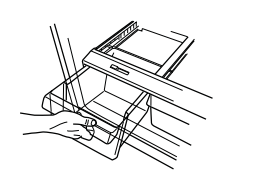
Cover Removal
1. Remove the drawers.
2. Reach in, push the back of glass cover up, and at the same time, pull it backward as far as it will come. Tilt it and take it out. Avoid cleaning the cold glass cover with hot water because the extreme temperature difference may cause it to break.
3. Remove the drawer frame. (Always remove the glass cover before you take out the drawer frame.) Lift the frame off the supports at each side and back, pull it forward, tilt it and take it out.
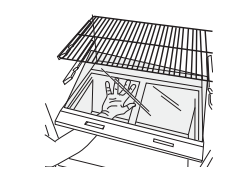
To replace:
1. Lower the frame until it rests on the supports at each side and back.
2. Replace the glass cover, pushing its front edge firmly into the front frame channel and gently lowering the back into place.
3. Replace the drawers
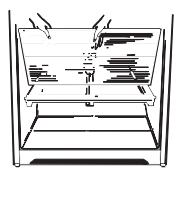
Automatic Icemaker
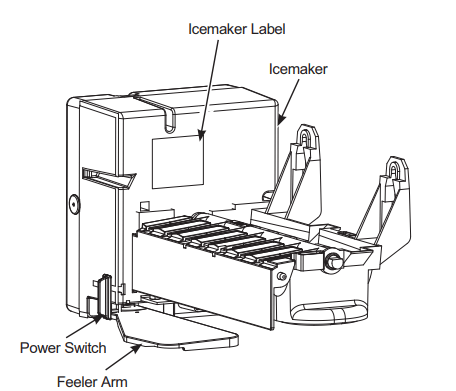
MPORTANT: This refrigerator requires a red label icemaker. See above for the location of the label on the icemaker. If the icemaker that came with your kit does not have a red label, it will not function. In this case, please call 800.GE.CARES (in Canada 800.561.3344) for the correct icemaker.
Care And Cleaning
Cleaning the Outside
Directions for Cleaning Outside Surfaces, Door Handles, and Trim

Cleaning the Inside
To help prevent odors, leave an open box of baking soda in the fresh food and freezer compartments.
Unplug the refrigerator before cleaning. If this is not practical, wring excess moisture out of sponge or cloth when cleaning around switches, lights or controls.
Use warm water and banking soda solution about a tablespoon (15 ml) of baking soda to a quart (1 liter) of water. This both cleans and neutralizes odors. Rinse and wipe dry. After cleaning the door gaskets, apply a thin layer of petroleum jelly to the door gaskets at the hinge side. This helps keep the gaskets from sticking and bending out of shape.
Moving the Refrigerator
Be careful when moving the refrigerator away from the wall. All types of floor coverings can be damaged, particularly cushioned coverings and those with embossed surfaces. Turn the leveling legs at each front corner of the refrigerator counterclockwise until the rollers support the refrigerator. Pull the refrigerator straight out and return it to position by pushing it straight in. Moving the refrigerator in a side direction may result in damage to the floor covering or refrigerator.
When pushing the refrigerator back, make sure you don’t roll over the power cord or ice maker supply line (on some models). After rolling the refrigerator back into place, turn the legs clockwise until the legs again bear the weight of the refrigerator.
Replacing the Lights
LED lighting is located at the top center of the fresh food compartment.
An authorized technician will need to replace the LED light
Preparing for Vacation
For long vocations or aabsences, remove food and unplug the refrigerator.
Move the temperature control dial to the OFF position, and clean the interior with a baking soda solution of one tablespoon (15 ml) of baking soda to one quart (1 liter) of water.
Leave the doors open.Move the switch to the OFF position on the power switch model, and shut off the water supply to the refrigerator.
If the temparature can drop below freezing, have a qualified servicer drain the water supply system (on some models) to prevent serious property damage due to flooding
Preparing to Move
Secure all loose items such as grille, shelves and drawers by taping them securely in place to prevent damage. To prevent the doors from opening while moving, secure them to the case with tape. Be sure the refrigerator stays in an upright position during moving
BEFORE YOU BEGIN Read these instructions completely and carefully.
• IMPORTANT- Save these instructions for local inspector’s use.
• IMPORTANT- Observe all governing codes and ordinances.
• Note to Installer- Be sure to leave these instructions with the Consumer.
• Note to Consumer- Keep these instructions for future reference.
• Skill level- Installation of this appliance requires basic mechanical skills.
• Completion time- Refrigerator installation 15 minuutes. Reversing the door swing 15 minutes
• Proper installation is the responsibility of the installer.
• Product failure due to improper installation is not covered under the Warranty
WATER SUPPLY TO THE ICE MAKER (on some models)
If the refrigerator has an icemaker, it will have to be connected to a cold water line. A water supply kit (containing copper tubing, shutoff valve, fittings and instructions) is available at extra cost from your dealer,
REFRIGERATOR LOCATION
Do not install the refrigerator where the temparature will go to below 55C because it will not run often enough to maintain proper temperatures.
Do not install the refrigerator where the temparature will go above 100f becase it will not perform properly
Do not install the refrigerator in a location exposed to water (rain, etc.) or direct sunlight.
Install it on a floor strong enough to support it fully loaded
CLEARANCES
Allow the following clearances for ease of installation, proper air circulation and plumbing and electrical connections.
ROLLERS AND LEVELING LEGS
Leveling legs near each front corner of the refrigerator are adjustable. They firmly position the refrigerator and prevent it from moving when the doors are opened. Leveling legs should be set so the front of the refrigerator is raised just enough that the doors close easily when opened about halfway.
Turn the leveling legs clockwise to raise the refrigerator, counterclockwise to lower it. Rollers next to the leveling legs allow you to move the refrigerator away from the wall for cleaning. Turn the legs counterclockwise until the weight of the refrigerator is transferred from them to the rollers. After rolling the refrigerator back into place, turn the legs clockwise until the legs again bear the weight of the refrigerator
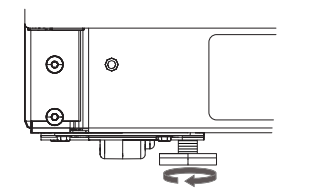
INSTALLING THE WATER LINE
WHAT YOU WILL NEED (Cont.)
Smartconnect Refrigerator Tubing Kits are available in the following lengths:
8’ (2.4 m) – WX08X10006
15’ (4.6 m) – WX08X10015
25’ (7.6) m) – WX08X10025
Be sure that the kit you select allows at least 6’ (1.8 m) as described above.
NOTE: The only GE Appliances approved plastic tubing is that supplied in SmartConnect™ Refrigerator Tubing Kits. Do not use any other plastic water supply line because the line is under pressure at all times. Certain types of plastic will crack or rupture with age and cause water damage to your home.
• A GE Appliances water supply kit (containing tubing, shutoff valve and fittings listed below) is available at extra cost from your dealer or from Parts and Accessories, 877.959.8688.
• A cold water supply. The water pressure must be between 20 and 120 psi (138 – 827 kilopascals) on models without a water filter and between 40 and 120 psi (275 – 827 kilopascals) on models with a water filter.
• Power drill.
• Straight and Phillips blade screwdriver.
Two 1/4 outer diameter compression nuts and 2 ferrules to coneect the copper tubing to the shutoff valve and the refrigerator water valve.
OR
If you are using a SmartConnect™ Refrigerator Tubing kit, the necessary fittings are preassembled to the tubing.
If your existing copper water line has a flared fitting at the end, you will need an adapter (available at plumbing supply stores) to connect the water line to the refrigerator OR you can cut off the flared fitting with a tube cutter and then use a compression fitting. Do not cut formed end from SmartConnect™ Refrigerator tubing.
Shutoff valve to connect to the cold water line. The shutoff valve should have a water inlet with a minimum inside diameter of 5/32 at the point of connection to the COLD WATER LINE. Saddle type shut off valves are included in many water suppply kits. Before purchasing, make sure a saddle type valve complies with your local pluming codes
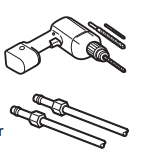

INSTALLING THE WATER LINE (Cont)
1:SHUT OFF THE MAIN WATER SUPPLY AND UNPLUG REFRIGERATOR
Turn on the nearest faucet (counterclockwise) long enough to clear the line of water.
2 CHOOSE THE VALVE LOCATION
Choose a location for the valve that is easily accessable. It is best to connect into the side of a vertical water pipe. When it is necessary to connect into a horizontal water pipe, make the connection to the top or side, rather than at the bottom, to avoid drawing off any sediment from the water pipe.

3 DRILL THE HOLE FOR THE VALVE
Drill a 1/4 hole in the water pipe ( even if using a self-piercing valve), using a sharp bit. Remove any burrs resulting from drilling the hole in the pipe. Take care not to allow water to drain into the drill. Failure to in reduced ice production or smaller cubes.

4 FASTEN THE SHUTOFF VALVE
Fasten the shutoff valve to the cold water pipe with the pipe clamp.
Tighten the clamp screws until the sealing washer begins to swell.
NOTE: Do not overtighten or you may crush the tubing
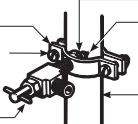
4 FASTEN THE SHUTOFF VALVE (Cont.)
NOTE: Commonwealth of Massachusetts Plumbing Codes 248CMR shall be adhered to. Saddle valves are illegal and use is not permitted in Massachusetts. Consult with your licensed plumber.
5 ROUTE THE TUBING
Route the tubing between the cold water line and the refrigerator.
Route the tubing through a hole drilled in the wall or floor (behind the refrigerator or adjacent base cabinet) as close to the wall as possible.
6 CONNECT THE TUBING TO THE VALVE
Place the compression nut and ferrule (sleeve) for copper tubing onto the end of the tubing and connect it to the shutoff valve. Make sure the tubing is fully inserted into the valve. Tighten the compression nut securely.
For plastic tubing from a SmartConnect™ Refrigerator Tubing kit, insert the molded end of the tubing into the shutoff valve and tighten compression nut until it is hand tight, then tighten one additional turn with a wrench. Overtightening may cause leaks
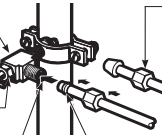
7 FLUSH OUT THE TUBING
Turn the main water supply on (counterclockwise) and flush out the tubing until the water is clear. Shut the water off at the water valve after about one quart (1 liter) of water has been flushed through the tubin

INSTALLING THE WATER LINE
8 CONNECT THE TUBING TO THE REFRIGERATOR NOTES:
Before making the connection to the refrigerator, be sure the refrigerator power cord is not plugged into the wall outlet.
We recommend installing a water filter (GXRLQ, available on gewaterfilters.com or 877.959.8688) if your water supply has sand or particles that could clog the screen of the refrigerator's water valve. Install in it SmartConnect™ Refrigerator Tubing kit, you will need an additional tube (WX08X10002) to connect the filter. Do not cut plastic tube to install filte
Remove the access cover.
Remove the plastic flexible or screw cap from the water valve (refrigerator connection) and discard.
Place the compression nut and ferrule (sleeve) onto the end of the tubing as shown. On SmartConnect™ Refrigerator Tubing kit, the nuts are already assembled to the tubing.
Inser the end of the tubing into the water valve connection as far as possible. While holding the tubing, tighten the fitting.
For plastic tubing from a SmartConnect™ Refrigerator Tubing kit, insert the molded end of the tubing into the shutoff valve and tighten compression nut until it is hand tight, then tighten one additional turn with a wrench. Overtightening may cause leaks
Fasten the tubing into the clamp provided to hold it in a vertical position. You may need to pry open the clamp.

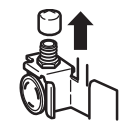
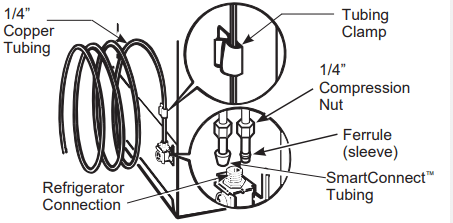
9 TURN THE WATER ON AT THE SHUTOFF VALVE
Tighten any connections that leak.
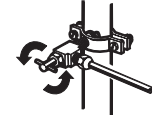
10 INSTALLING THE REFRIGERATOR
Plug in the refrigerator. Arrange the coil of tubing so that it does not vibrate against the back of the refrigerator or against the wall. Push the refrigerator back to the wall
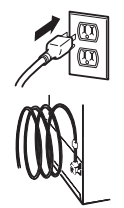
11 START THE ICE MAKER
Set the ice maker power switch to the 0N position. The ice maker will not begin to operate until it reaches its operating temperature of 15F or below. It will then begin operation automatically
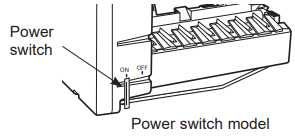
INSTALLING THE DOOR HANDLE
1:INSTALL FASTENER
Install the handle fastener into the hole on the freezer and fresh food doors. The fasteners correspond with the handle side (the side opposite the hinge).
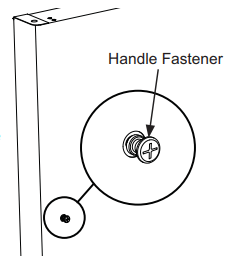
2 STAINLESS STEEL HANDLE
- Attach handle to freezer door with screws at the bottom of the handle. Use the icluded 1/8 allen wrench to tighten the set screw at the top of the handle. Tighten until handle is locked firmly into position.
- Attach handle to fresh food door with screws at the top of the handle. Use the icluded 1/8 allen wrench to tighten the set screw at the bottom of the handle. Tighten until handle is locked firmly into position
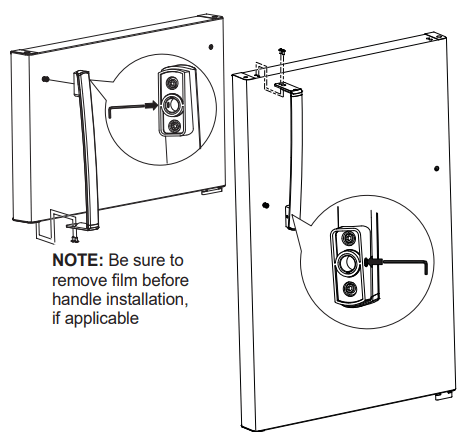
2A PLASTIC HANDLE
Attach handle to freezer door by sliding handle up onto fastener and with screws at the bottom of the handle.
Attach handle to fresh food door by sliding handle down onto fastener and with screws at top of handle
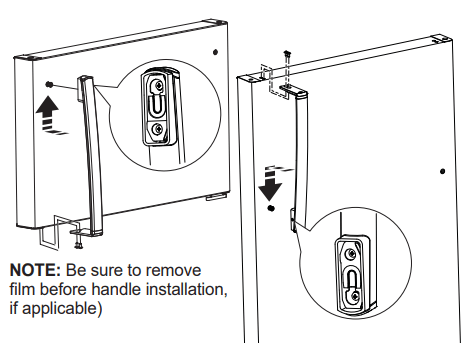
3 BADGE AND PLUG BUTTON INSTALLATION
- . Place a plug button on the opposite side of the fresh food door across from the handle.
- . Remove the backing on the GE Appliances badge and carefully place it in the hole opposite the handle on the freezer door. Be sure the badge is oriented the correct way before applying it to the door
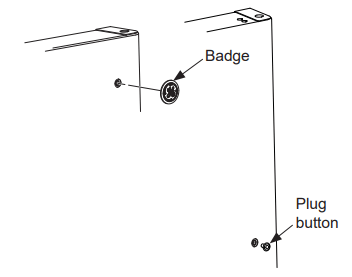
REVERSING THE DOOR SWING
IMPORTANT NOTES:
When reversing the door swing:
• Read the instructions all the way through before starting.
• Handle parts carefully to avoid scratching paint.
• Set screws down by their related parts to avoid losing them.
• Provide a non-scratching work surface for the doors.
IMPORTANT: Once you begin, do not move the cabinet until door-swing reversal is completed. These instructions are for changing the hinges from the right side to the left side change the hinges back to the right side, follow these same instructions and reverse all references to left and right
TOOLS REQUIRED

1 BEFORE YOU START
- Unplug the refrigerator from its electrical outlet.
- Empty all door shelves, including the dairy compartment
2 REMOVE THE FREEZER DOOR
2.1 Tape the door shut with masking tape.
2.2 Remove the screws that hold the top hinge to the cabinet.
2.3 Lift the hinge straight up to free the hinge pin from the socket in the top of the door and set it aside, along with its screws.
2.4 Remove the tape. Lift it off the center hinge pin.
2.5 Set the door on a non-scratching surface with the outside up.
2.6 Transfer the 2 screws from the opposite side of the cabinet to the screw holes vacated by the top hinge removal.
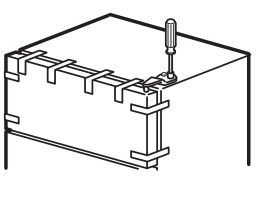
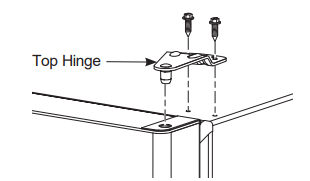
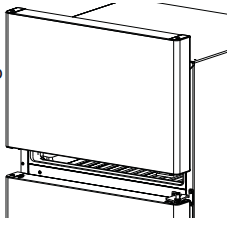
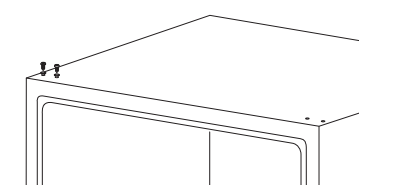
3 REMOVE THE FRESH FOOD DOOR
3.1 Tape the door shut with masking tape.
3.2 Unscrew the cemter hinge pin and remove it from its socket. Be careful not to lose the center hinge and washer.
3.3 Remove the tape and tilt the door away from the cabinet. Lift the door from the pin in the bottom hinge.
3.4 Set the door outside-up on a non-scratching surface.



4 REVERSING THE HARDWARE
4.1 Interchange the hinge and screws at top right with screws at top left of cabinet. Do not tighten screws on hinge side.
NOTE: Some hinges have 4 holes. Which holes you use for installing depends on which side you install the hinge. The outer edge of the hinge should be parallel to the edge of the case for correct installation.
4.2 Remove the three screws holding the center hinge to the cabinet.
4.3 Transfer the three screws from the opposite side of the cabinet to the screw holes vacated by the center hinge removal.
4.4 Reattach the center hinge with all three screws on the left side of the cabinet.
NOTE: The center hinge must be turned over as shown when mounted on the left side.
4.5 Remove the screws holding the bottom hinge to the cabinet. Move the bottom hinge from the right to left side of the cabinet. Switch the hinge pin to the opposite side of the hinge and reinsert the screws.

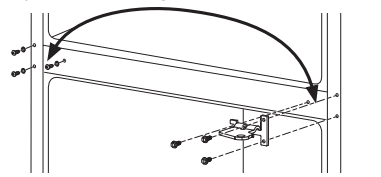
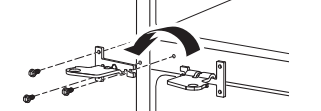
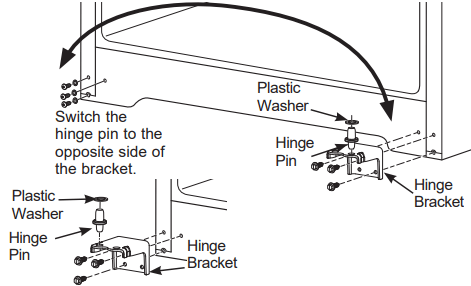
5 REVERSING THE DOOR HANDLES STAINLESS STEEL HANDLE
5.1a. Remove handle screws from the top of fresh food door. Remove handle screws from the bottom of freezer door
5.2a. Loosen set screw on handle with the provide 1/8 wrench
5.3a. Remove door handle.
5.4a. Change places between the handle fastener and plug button on door front.
5.5a. Move the plug buttons on top and front of the door to fill the now vacant holes.
5.6a. Transfer the door stop on the bottom of the door
5.7a. Attach handle to fresh food door with screws at top og handle. Use 1/8 allen wrench to tighten set screw at bottom of handle.
5.8a Attach handle to freezer door with screws at bottom of handle. Use the provided 1/8 allen wrench to tighten set screw at top of handle.
5.9a Attach badge on freezer door opposite the handle
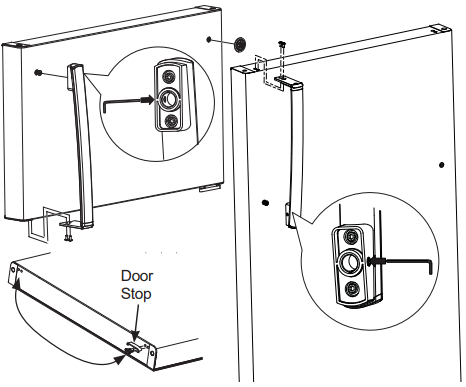
PLASTIC HANDLE ASSEMBLY
5.1b. Remove handle screws from the top of fresh food door. Remove handle screws from the bottom of freezer door
5.2b. Remove door handle on fresh food door by sliding the handle up off of the fastener. remove door handle on freezer door by sliding the handle down off of the fastener.
5.3b. Change places between the handle fastener and plug button on door front.
5.4b. Move the plug buttons on top and front of the door to fill the now vacant holes.
5.5b. Transfer the door stop on the bottom of the door.
5.6b. Attach handle to fresh food door by sliding handle down onto fastener and with screws at top of handle.
5.7b Attach handle to freezer door by sliding handle up onto fastener and with screws at bottom of handle.
5.8b Attach badge on freezer door opposite the handle
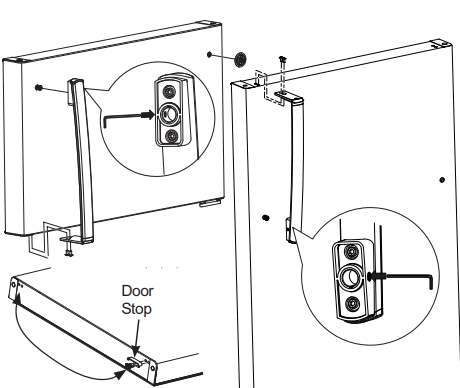
6 RE-HANGING THE DOORS
6.1 Re-hang the fresh food door
6.1.1 Lower the fresh food door onto the bottom hinge pin. Be sure the washer is in place on the pin.
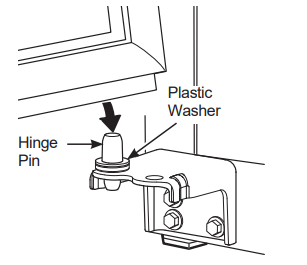
6.1.2 Tilt the door towards the cabinet. As the door is brought into position, align the socket in the door with the hole in the center hinge. Place the center hinge pin into the hole in the center hinge and tighten. Make sure the washer is on the top of the hinge pin.
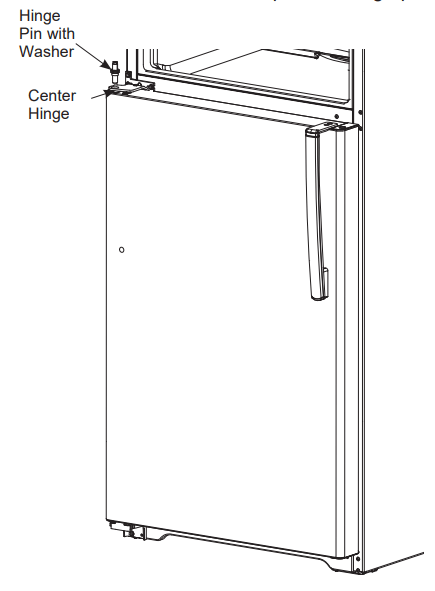
6.1 Re-hang the fresh food door
6.2.1 Lower the freezer door onto the center hinge pin. Be sure the washer is in place on the pin.
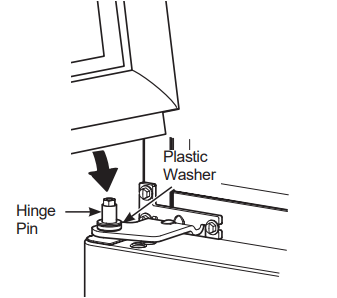
6.2.2 Tilt the door towards the cabinet, lifting the top hinge so the pin fits into the socket on the top of the door.
6.2.3 Make sure the door is slightly above the top of the cabinet and the gap between the doors is even across the front. Tighten the top hinge crews. Do not over-tighten these screws. Tighten them until they are just snug, and then turn them another one-half turn.
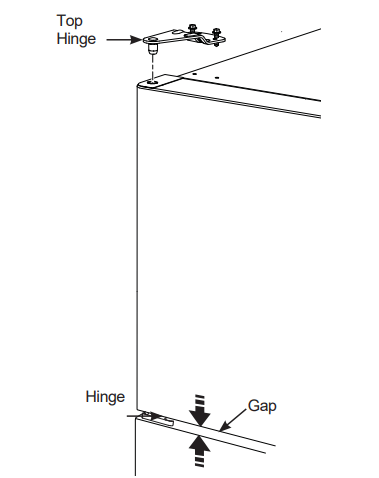
Troubleshooting Tips.
| Truth or Myth? | Answer | Explanation |
| The automatic ice maker in my refrigerator will produce ice when the refrigerator is plugged in to a power receptacle. | MYTH | The refrigerator must be connected to water, and the ice maker must be turned on. Make sure the ice maker is turned on, only after the water line is connected and water is turned on. The icemaker can be turned off by switching it to the OFF position. The freezer must be 15 degrees or colder before the icemaker will produce ice. Please allow at least 24 hours for the refrigerator to pull down and the unit’s temperature to stabilize. |
| I will never see frost inside the freezer compartment | MYTH | Frost inside the freezer typically indicates that the door is not properly sealed, or has been lest open. If frost is found, clear the frost using a plastic spatula and tower, then check to ensure that no food packages or containers are preventing the freezer door from closing. To help reduce to the potential for frost please make sure there is proper clearance to the air supply and vents in the freezer to improve circulation. Always cover food before loading into the refrigerator, moisure from open containers can add to the frost load. |
| The automatic ice maker in my refrigerator will produce ice when the refrigerator is plugged in to a power receptacle | MYTH | The refrigerator must be connected to water, and the ice maker must be turned on. Make sure the ice maker is turned on, only after the water line is connected and water is turned on. The icemaker can be turned off by switching it to the OFF position. The freezer must be 15 degrees or colder before the icemaker will produce ice. Please allow at least 24 hours for the refrigerator to pull down and the unit’s temperature to stabilize. |
| I will never see frost inside the freezer compartment | MYTH | Frost inside the freezer typically indicates that the door is not properly sealed, or has been lest open. If frost is found, clear the frost using a plastic spatula and tower, then check to ensure that no food packages or containers are preventing the freezer door from closing. To help reduce to the potential for frost please make sure there is proper clearance to the air supply and vents in the freezer to improve circulation. Always cover food before loading into the refrigerator, moisure from open containers can add to the frost load. |
| Refrigerator door handles can be easily tightened. | TRUE | If door handles are loose or have a gap, the handle can be adjusted with set screws located on the ends of the handles. |
| After starting the ice maker throw away 24 hours of ice production | TRUE | To avoid issues with odor and taste the first batch of ice should be discarded |
| Door removal is always required for installation. | MYTH |
Door should only be removed when necessary to prevent damage from passage way or access to final loaction. If doors are removed please review reversing the door swing section for re-hang procedure |
| There is an adjustment to rear wheels. | MYTH |
Front leveling legs are adjustable and should be used to balance the refrigerator. Leveling legs are used to make initial fresh food door adjustment. There should be approximately a 1/4 fall from the front to abck to ensure that the doors always close |
| Any All-Purpose cleaner can be used to clean my refrigerator. | MYTH | All-purpose cleaners are not recommended for use on the refrigerator. Do not use wax, polish, ammonia, bleach, or other products containg chlorine on for any surfaces. Clean with a cloth dampened with soapy water. Dry with a soft cloth.The stainless steel doors can be cleaned with a commercially available stainless steel. Use only a liquid cleanser free of grit and rub in the direction of the brush lines with a damp soft sponge. Do not use appliance wax or polish on the stainless steel |
| Gaskets will last longer with regular cleaning and maintenance. | TRUE | Clean gaskets with warm soapy water. Make sure all folds are clean and dry after cleaning. Make sure flanges are clear of any grit or grime. After cleaning the door gaskets, apply paraffin wax or petroleum jelly to the door gaskets and hinges at the hinge side. This helps keep the gasskets from sticking and bending out of shape |
| Doors may be shipped with protective film that has to be removed before use | TRUE | Smooth finished doors will have a clear plastic film on the door that must be removed after install |
See other models: PS950SF2SS FCM22DLAWW JES1460DN1BB JVM1653WH03 GSE26GSEBCSS
